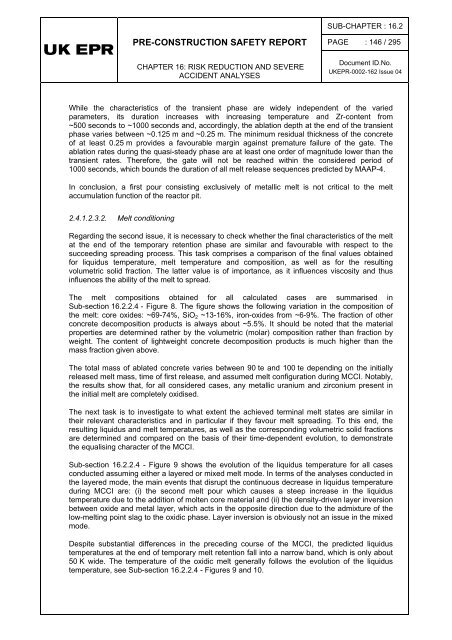16.2 - Severe Accident Analysis (RRC-B) - EDF Hinkley Point
16.2 - Severe Accident Analysis (RRC-B) - EDF Hinkley Point
16.2 - Severe Accident Analysis (RRC-B) - EDF Hinkley Point
You also want an ePaper? Increase the reach of your titles
YUMPU automatically turns print PDFs into web optimized ePapers that Google loves.
SUB-CHAPTER : <strong>16.2</strong>PRE-CONSTRUCTION SAFETY REPORTCHAPTER 16: RISK REDUCTION AND SEVEREACCIDENT ANALYSESPAGE : 146 / 295Document ID.No.UKEPR-0002-162 Issue 04While the characteristics of the transient phase are widely independent of the variedparameters, its duration increases with increasing temperature and Zr-content from~500 seconds to ~1000 seconds and, accordingly, the ablation depth at the end of the transientphase varies between ~0.125 m and ~0.25 m. The minimum residual thickness of the concreteof at least 0.25 m provides a favourable margin against premature failure of the gate. Theablation rates during the quasi-steady phase are at least one order of magnitude lower than thetransient rates. Therefore, the gate will not be reached within the considered period of1000 seconds, which bounds the duration of all melt release sequences predicted by MAAP-4.In conclusion, a first pour consisting exclusively of metallic melt is not critical to the meltaccumulation function of the reactor pit.2.4.1.2.3.2. Melt conditioningRegarding the second issue, it is necessary to check whether the final characteristics of the meltat the end of the temporary retention phase are similar and favourable with respect to thesucceeding spreading process. This task comprises a comparison of the final values obtainedfor liquidus temperature, melt temperature and composition, as well as for the resultingvolumetric solid fraction. The latter value is of importance, as it influences viscosity and thusinfluences the ability of the melt to spread.The melt compositions obtained for all calculated cases are summarised inSub-section <strong>16.2</strong>.2.4 - Figure 8. The figure shows the following variation in the composition ofthe melt: core oxides: ~69-74%, SiO 2 ~13-16%, iron-oxides from ~6-9%. The fraction of otherconcrete decomposition products is always about ~5.5%. It should be noted that the materialproperties are determined rather by the volumetric (molar) composition rather than fraction byweight. The content of lightweight concrete decomposition products is much higher than themass fraction given above.The total mass of ablated concrete varies between 90 te and 100 te depending on the initiallyreleased melt mass, time of first release, and assumed melt configuration during MCCI. Notably,the results show that, for all considered cases, any metallic uranium and zirconium present inthe initial melt are completely oxidised.The next task is to investigate to what extent the achieved terminal melt states are similar intheir relevant characteristics and in particular if they favour melt spreading. To this end, theresulting liquidus and melt temperatures, as well as the corresponding volumetric solid fractionsare determined and compared on the basis of their time-dependent evolution, to demonstratethe equalising character of the MCCI.Sub-section <strong>16.2</strong>.2.4 - Figure 9 shows the evolution of the liquidus temperature for all casesconducted assuming either a layered or mixed melt mode. In terms of the analyses conducted inthe layered mode, the main events that disrupt the continuous decrease in liquidus temperatureduring MCCI are: (i) the second melt pour which causes a steep increase in the liquidustemperature due to the addition of molten core material and (ii) the density-driven layer inversionbetween oxide and metal layer, which acts in the opposite direction due to the admixture of thelow-melting point slag to the oxidic phase. Layer inversion is obviously not an issue in the mixedmode.Despite substantial differences in the preceding course of the MCCI, the predicted liquidustemperatures at the end of temporary melt retention fall into a narrow band, which is only about50 K wide. The temperature of the oxidic melt generally follows the evolution of the liquidustemperature, see Sub-section <strong>16.2</strong>.2.4 - Figures 9 and 10.













![6.3 - Safety Injection System (RIS [SIS]) - EDF Hinkley Point](https://img.yumpu.com/42739985/1/184x260/63-safety-injection-system-ris-sis-edf-hinkley-point.jpg?quality=85)


